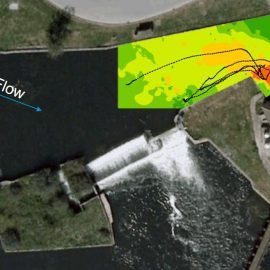Areas of abrupt acceleration of flow are commonly encountered at engineered in-river structures (e.g. weirs, culverts, turbine intakes and fish pass entrances). Many species are tuned to avoid such hydraulic conditions. At engineered structures, this can lead to delayed migration, increased risk of predation and increased energetic cost of downstream migration.
To assist in the design of effective fish passage mitigation, a research programme at ICER aims to better understand how multiple species of fish respond to velocity gradients and the hydraulic thresholds at which behavioural avoidance occurs. In addition, experiments utilising multimodal stimuli (e.g. light and turbulence) are being undertaken, within the context of signal detection theory, in an attempt to mask velocity gradients and facilitate faster passage. Results from a series of studies show both salmonids and adult European eel (Anguilla anguilla) to be responsive to velocity gradients, with behaviours dramatically impacting subsequent rate of downstream movement. Light increased responsiveness, and turbulence did not mask a velocity gradient for salmonids.
The effect of a parasitic nematode infestation (Anguillicoloides crassus) on the behavioural response of adult European eel at velocity gradients has also being investigated. A. crassus infests the swim bladder of the eel and consumes their blood through the swim bladder wall. The nematode is thought to reduce the energy reserves of eels and hamper their extensive migration back to the Sargasso Sea. Members of ICER are investigating whether this parasitic nematode affects not only eel energy reserves but also their behaviour. Changes in behaviour, such as enhanced avoidance of velocity gradients, could compound the debilitative effect of parasitic infestation.
Media:
Publications:
Kemp P.S., Gessel M.H. & Williams J.G. (2005). Fine-Scale behavioral responses of Pacific salmonid smolts as they encounter divergence and acceleration of flow. Transactions of the American Fisheries Society 134, 390-398 (DOI: 10.1577/T04-039.1)
Kemp P.S., Gessel M.H. & Williams J.G. (2008). Response of downstream migrant juvenile Pacific salmonids to accelerating flow and overhead cover. Hydrobiologia 609, 205-207 (DOI: 10.1007/s10750-008-9412-2)
Russon I.J. & Kemp P.S. (2011). Advancing provision of multi-species fish passage: behavior of adult European eel (Anguilla anguilla) and brown trout (Salmo trutta) in response to accelerating flow. Ecological Engineering 37, 2018-2024 (DOI: 10.1016/j.ecoleng.2011.08.005)
Vowles A.S. & Kemp P.S. (2012). Effects of light on the behaviour of brown trout (Salmo trutta) encountering accelerating flow: application to downstream fish passage. Ecological Engineering 47, 247-253 (DOI: 10.1016/j.ecoleng.2012.06.021)
Vowles, A.S., Anderson, J.J., Gessel, M.G., Williams, J.G. & Kemp, P.S. (2014). Effects of avoidance behavior on downstream fish passage through areas of accelerating flow when light and dark. Animal Behaviour 92, 101-109. (doi:10.1016/j.anbehav.2014.03.006)
Newbold, L.R., Hockley, F.A., Williams, C.F., Cable, J., Reading, A.J., Auchterlonie, N. & Kemp, P.S. (2015). Relationship between European eel Anguilla anguilla infection with non-native parasites and swimming behaviour on encountering accelerating flow. Journal of Fish Biology 86, 1519-1533 (doi:10.1111/jfb.12659)
Piper, A.T., Manes, C., Siniscalchi, F., Marion, A., Wright, R.M. & Kemp, P.S. (2015). Response of seaward migrating European eel (Anguilla anguilla) to manipulated flow fields. Proceedings of The Royal Society B: Biological Sciences 282, 1-9 (doi: 10.1098/rspb.2015.1098)
People:
Dr. Lynda Eakins
Prof. Paul Kemp
Dr. James Kerr
Dr. Adam Piper
Dr. Iain Russon
Dr. Andrew Vowles


